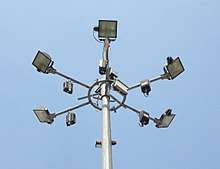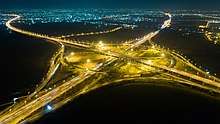High-mast lighting
High-mast lighting is a tall pole with lighting attached to the top pointing towards the ground, usually but not always used to light a highway or recreational field. It is used at sites that require lighting over a large area. The pole that the lighting is mounted on is generally at least 30 m (98 ft) tall (under this height it is referred to as conventional lighting system),[1] while the lighting consists of a luminaire ring surrounding the pole with one or several independent lighting fixtures mounted around it. Most units have four, six or eight lights in the ring, with three, five, ten, twelve and sixteen lights used in rarer instances. While most high-mast lights are high-pressure sodium, other types such as mercury vapor, metal halide and LED, have also been used. Some units have the lighting surrounded by a circular shield to prevent or reduce light pollution or light trespass from affecting neighbourhoods adjacent to the highway.[2] [1]




Maintenance of these systems are done by lowering the luminaire ring from the mast head to the base using a winch and motor to the ground or at a height accessible by a cherry picker and located in areas to allow for easier access without disrupting traffic.[1]
References
- Lopez, Carlos A. (1 November 2003). "Section 4: Conventional vs. High Mast Lighting". Highway Illumination Manual. Retrieved 31 October 2011.
- "Highway Lighting Unit Construction". Archived from the original on 3 April 2007. Retrieved 31 October 2011.
See also
| Wikimedia Commons has media related to Light towers. |